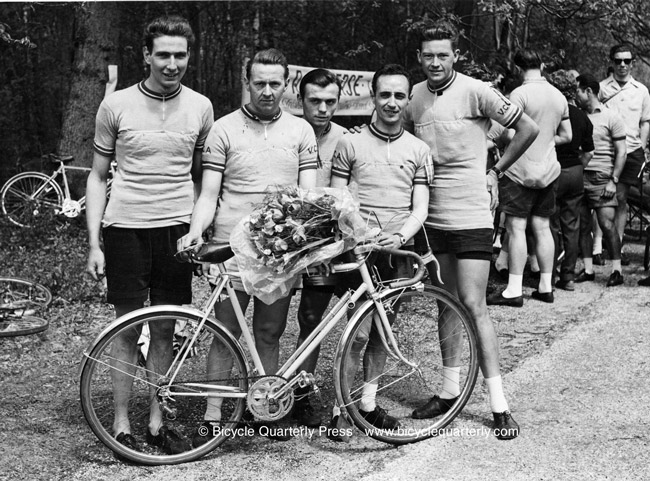Doping in Randonneuring?

With the recent news that Lance Armstrong effectively admitted to a large-scale doping conspiracy on his teams, the issue of doping has been front and center in the cycling news. A few readers have asked whether doping exists in randonneuring, too.
The short answer is yes – doping exists in any sport. A random test during a French cyclosportive (a timed long-distance ride) found astonishing numbers of riders with forbidden substances in their urine and bloodstream. Interestingly, it was not so much the faster riders who resorted to doping, but those who really wanted to beat 10 or 12 hours for a 200 km event.
What about the fast randonneurs of the past, the ones you read about in Bicycle Quarterly? Many of them have admitted to taking amphetamines, of the type the Air Force administers to its pilots. Like the Air Force pilots, they took these medications not to improve performance, but to fend off sleep.
Roger Baumann (on the right in the photo above) was the fastest single-bike rider in the 1956 PBP. He told me: “Most of us took it. Daniel Rebour said it was better to take it than to crash into an oncoming car.” At the time, the over-the-counter product, called Maxiton, was not yet on the list of forbidden substances, so technically, it wasn’t doping.
Gilbert Bulté (second from right in photo), who was part of the fastest tandem in that year’s PBP, also questioned its effectiveness: “I took three pills during the 50 hours of PBP. When I later told a doctor about this, he said: ‘Considering how much you ate and drank during the ride, the amphetamines had absolutely no effect.'”
From my own experience, I know that with experience, it is not difficult to stay awake for a 50+ hour ride, even without coffee or other stimulants, unless it involves long mountain descents where the rider does not pedal. So perhaps it was all about a placebo effect.
Among these old randonneurs, there are some behind-the-back stories of “x en a pris (used to take it),” but few of these stories can be corroborated. It is hard to know for sure, but considering how open and honest these randonneurs have been about other thorny issues, I suspect that they are telling the truth, and that performance-enhancing doping was very rare.
What about lead groups in recent PBPs? Having ridden with them for hundreds of kilometers in 2007, I was surprised that their pace was not as fast as that of typical racers. When we approached the first control, everybody was jockeying for position on the last climb, knowing that only the first riders would get through the control without delay. It was not difficult for me to maintain a position in the top five of the group. My conclusion was that you don’t need to resort to doping to stay with the lead group. More important is an efficient support team and consistency – I lost significant time and had to chase hard because I had to get my own water at the control. On the road, it appears that riders get dropped not because they aren’t fast enough, but because they suffer from a weak moment or two.
For everybody else, a fast time in a brevet mostly depends on managing your off-the-bike time well. No amount of doping will make you faster at the controls. So yes, it is likely that there is doping in randonneuring – as there is abuse of medication in all parts of society. But unlike in professional bike racing, doping is not a prerequisite for success in randonneuring, however one chooses to define that success.
P.S.: For the comments, I will discard comments about Mr. Armstrong, since he has been discussed on many other forums. I’d like to keep the discussion focused on doping in randonneuring and other amateur sports.


